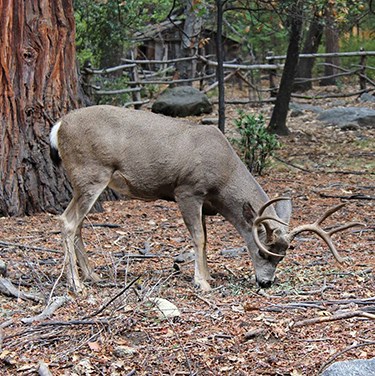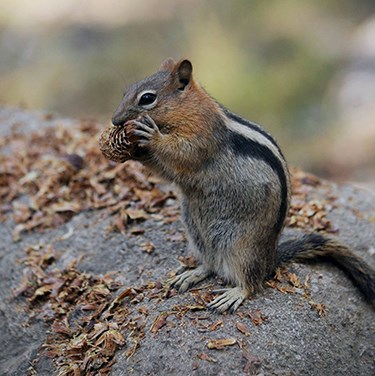I got up at 3:45 Am this morning to watch the sunrise over Half Dome in Yosemite from Glacier point. About 20 other people were there too to witness Summer Solstice Sunrise at Glacier point as well. The sunrise was supposed to be at 5:37. However, it was 6 o'clock or later before the sun rose above Half dome itself while we watched the sunlight slowly encompass the valley around Half Dome from Glacier Point
However as I was walking around I noticed what looked like Golden mantle Ground squirrels like we have up in the Mount Shasta Area. But they seemed much smaller than the ones at lower altitudes. However, Glacier Point is 7,214 feet which is 2,199 meters in Altitude and I noticed the squirrels were much smaller than ones at lower altitudes and wondered why.
I got a simple answer when I walked over to where I could look down 3200 feet straight down from Glacier point and saw a litle Golden mantle Squirrel running on 45 degree angle granite pieces like you or I would walk our dogs down a city street. I wondered how many little (or big) golden mantle Ground squirrels had fallen the 3200 feet straight down into the valley? and I realized that likely having smaller feet (as in smaller squirrels) would be an advantage in gripping very small gradations in the Granite while running on 45 degree or more angle slabs of granite with 3200 feet of exposure down into Yosemite Valley below.
Images for golden mantle ground squirrel in yosemite?
Golden-mantled Ground Squirrel - Yellowstone National Park (U.S. ...
https://www.nps.gov/yell/learn/nature/golden-mantled-ground-squirrel.htm
Jul 11, 2017 - Golden-mantled ground squirrels are mammals in Yellowstone National Park. NPS. Black tracks of a golden-mantled ground squirrel ...begin quote from:
Mammals - Yosemite National Park (U.S. National Park Service)
https://www.nps.gov/yose/learn/nature/mammals.htm
Feb 13, 2017 - The golden-mantled ground squirrel looks similar to a chipmunk because it has stripes on its back (though, is larger), and the California ground ...
Yosemite
National ParkCalifornia
Mammals
Yosemite National Park's approximately 90 mammal species, and their behaviors, are truly fascinating for park visitors to observe safely and responsibly. Seventeen mammals have a special status by either the federal or California state governments due to declining population numbers or to a lack of information about their numbers and distribution. Ongoing research has put a magnifying lens on several mammal species within the park and continues to build on work in the 1920s by famous mammal researcher Joseph Grinnell.
 Black bears
American black bears found in Yosemite have long been of intense interest to park visitors and managers.
 Sierra Nevada bighorn sheep
Sierra Nevada bighorn sheep are once again at home in Yosemite's supremely beautiful Cathedral Range after an absence of over 100 years.
 Sierra Nevada Red Fox
A photo of a red fox padding atop a crest of snow in the far northern wilderness of Yosemite was proof that this creature is still alive.
 Pacific Fisher
Yosemite's wildlife staff have deployed motion-activated cameras in targeted locations to learn more about fishers and help them survive.
 Mountain Lions
Mountain lions—also called cougars, pumas or panthers—roam Yosemite’s mountains and valleys and are a natural part of the landscape.
 Bats
Yosemite is home to 17 species of bats, the only mammals capable of flight.
 DeerIn Yosemite Valley, mule deer are especially common, seen browsing on leaves and tender twigs from trees, grass, and herbs. Male mule deer grow antlers each year and are a factor in the dominance hierarchy among males, both visually, and in jousting among males for mating access to females. Although they seem disinterested in humans, deer should be treated as any other wild animal. Human injuries can occur from people offering food to deer or any other wild animal. More injuries in Yosemite are inflicted by deer, with one documented death, than those caused by black bear or any other park animal. Additionally, human food is not healthy for wild animals, and it is illegal to feed any animal in the park.  RodentsRodents comprise the highest proportion of Yosemite's mammals species. The oft-sighted squirrels species are in the rodent order, with other members: mice, gophers, and chipmunks. It's worth taking a moment to learn the four common squirrels visitors are most likely to see. The Western gray squirrel is gray with a long bushy tail and spends much of its time in trees. The Douglas squirrel (or chickaree) is a reddish tree squirrel that chews on pine cones and commonly squeaks. The golden-mantled ground squirrel looks similar to a chipmunk because it has stripes on its back (though, is larger), and the California ground squirrel-the most commonly seen squirrel in Yosemite-is brown, with white specks, and lives in burrows in the ground. The largest native rodent of the Sierra Nevada to watch for is the yellow-bellied marmot, found at higher elevations, like Olmsted Point on the Tioga Road, often sunning itself on rocks. This 5-pound mammal looks similar (and is related) to a woodchuck. |
Last updated: February 13, 2017
No comments:
Post a Comment